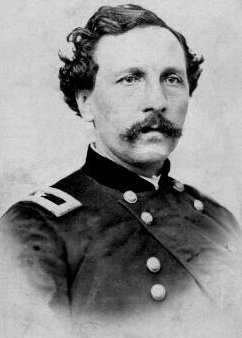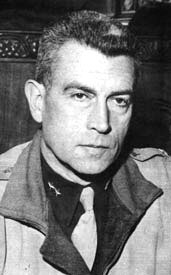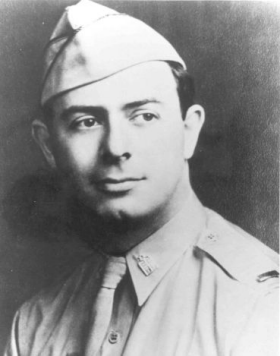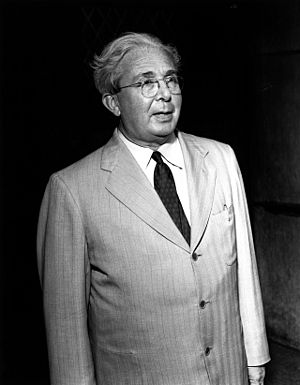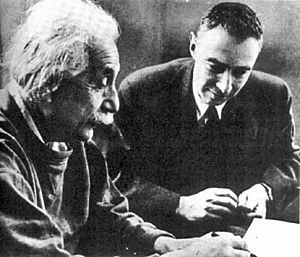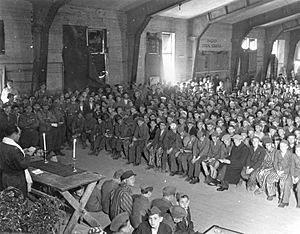Military history of Jewish Americans facts for kids
Jewish Americans have a long history of serving in the U.S. armed forces, even before the country became independent. They were part of local groups called militias in the Thirteen Colonies. Jewish soldiers have served in every part of the military and in all major wars the United States has been involved in. In 2006, about 4,000 Jewish men and women were actively serving.
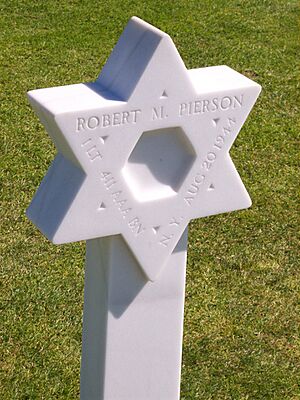
Many Jewish American service members have become famous for their bravery and service. More than 20 have received the Medal of Honor, which is the military's highest award. Many other Jewish Americans who served in the military later became important in business, politics, science, and entertainment. Scientists like Albert Einstein, J. Robert Oppenheimer, Richard Feynman, and Edward Teller were also Jewish and played a big part in developing military science and technology, especially with the Manhattan Project that created the first nuclear weapons.
Contents
- Jewish Americans in Major Wars
- Cold War Contributions
- Jewish Leaders in the U.S. Navy
- Secretaries of Defense
- Intelligence Work for America
- Special Forces and Missions
- Military Chaplains
- Jewish War Veterans of the United States of America
- National Museum of American Jewish Military History
- Misconceptions About Jewish Service
- Religious Practices During World War II
Jewish Americans in Major Wars
Serving in the French and Indian War
There isn't a lot of information about Jewish people in this war before the U.S. became independent. However, a historian named Simon Wolf found records of one Jewish man from New York who became a captain, and two others who served in a journey across the Allegheny Mountains.
Revolutionary War Heroes
Even though there were only about 3,000 Jewish people in America at the time, a large number of them served in the American Revolutionary War. About 160 Jewish soldiers fought for the American side. One of the first known Jewish soldiers to die for American independence was Francis Salvador.
Haym Solomon: A Friend to the Revolution
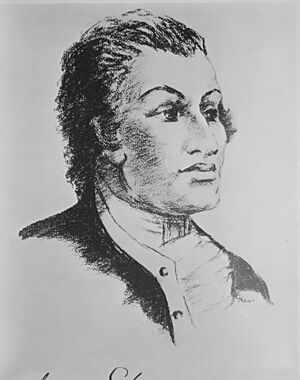
Haym Solomon (1740–1785) was born in Poland and moved to New York. He became a close friend of George Washington and was a very important person in helping to pay for the Continental Army during the Revolutionary War.
Solomon worked as an agent for the French consul and was also the paymaster for French forces in North America. He worked closely with Robert Morris, who was in charge of money for the Thirteen Colonies. Solomon helped sell many financial papers to American merchants, which brought in money for the war. He also personally supported members of the Continental Congress, like James Madison, often without asking for repayment.
One time, when Washington's army and the government's money ran out, Washington needed $20,000 to continue the fight. Morris told him there was no money left. Washington simply said, "Send for Haym Salomon." Haym came through again, and the money was raised. This allowed Washington to lead the Yorktown campaign, which was the final battle of the Revolution.
Civil War Contributions
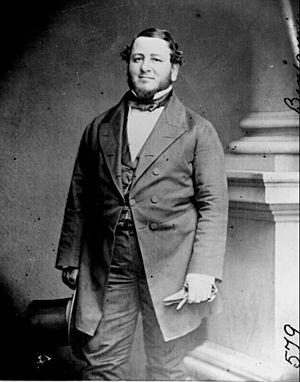
During the American Civil War, Jewish people lived in both the Northern and Southern states. They supported and served in both the Union Army (for the North) and the Confederate States Army (for the South). About 150,000 Jewish people lived in the U.S. at that time. It's estimated that at least 8,000 Jewish soldiers fought in the war, with about 7,000 for the Union and 3,000 for the Confederacy. Around 600 Jewish soldiers died in battle.
Jewish leaders also played important roles. Nine Jewish generals and 21 Jewish colonels fought in the war. Judah P. Benjamin, a Jewish man, served as Secretary of State and acting Secretary of War for the Confederacy.
Jewish People in the Union Army
The Civil War also saw the first official Jewish chaplain in the U.S. Army, Rev. Jacob Frankel. In 1861, Congress had passed a rule saying military chaplains had to be Christian. After protests from Jewish groups and meetings with President Lincoln, this rule was changed. Rev. Frankel was appointed on September 18, 1862. This was a big step for Jewish Americans in the military.
About 7,000 Jewish soldiers fought for the Union. Most served alongside Christian soldiers, but some units had many Jewish members.
Four Jewish generals served the Union and became important leaders:
- Brigadier General Frederick Salomon joined the Union Army in 1861. He fought in battles like Helena and Jenkins Ferry. He was promoted to major general in 1865.
- Brigadier General Leopold Blumenberg was badly wounded at the Battle of Antietam. He was given an honorary general rank.
- Brigadier General Frederick Knefler fought in many battles, including Perryville and Missionary Ridge. He was promoted for his bravery in 1865.
- Brigadier General Edward S. Salomon led the 82nd Illinois regiment, which included over 100 Jewish soldiers, at the Battle of Gettysburg. He quickly rose through the ranks because of his strong leadership.
Jewish People in the Confederacy
About 3,000 Jewish soldiers fought for the Confederacy. The most well-known Jewish figure was Judah P. Benjamin (1811–1884). He was born in Saint Croix to a Jewish family and later became the first Jewish Cabinet member in a North American government. He was called the "brains of the Confederacy" and served as Attorney General, Secretary of War, and Secretary of State.
Benjamin faced unfair anti-Jewish attacks when he became acting Secretary of War. He also argued with Confederate generals about war plans. In 1864, he suggested freeing slaves who were willing to fight for the Confederacy, but this idea was strongly opposed by many. It was finally passed in March 1865, but it was too late to help the Southern cause.
Other important Jewish figures in the Confederacy included Colonel Abraham Myers, the Quartermaster General, and Dr. David Camden de Leon, the Surgeon General. Dr. Simon Baruch, a surgeon, served on General Robert E. Lee's personal staff.
In 1862, Union General Ulysses S. Grant issued a controversial order, General Order No. 11, which ordered all Jewish people to leave the states under his control. This order was later canceled.
Major Raphael J. Moses, a businessman from Georgia, carried out the last order of the Confederate government. He delivered $40,000 in gold and silver to defeated Confederate soldiers. All three of his sons served in the Confederate Army, and one was killed in battle.
World War I Service
Jewish soldiers served in World War I in numbers higher than their percentage of the population. In the 77th Division, many soldiers were Jewish. This division fought bravely and included the famous "Lost Battalion of the Argonne." Sgt. Ben Kaufman won the Medal of Honor for his heroism in helping the Lost Battalion.
Another inspiring story is that of William Shemin. He bravely ran across a battlefield three times to rescue wounded comrades. He then took command of his unit and led them to safety. He received the Distinguished Service Cross for his actions. Later, a law was passed to review cases of Jewish soldiers who might have been overlooked for the Medal of Honor because of their faith.
World War II Heroes
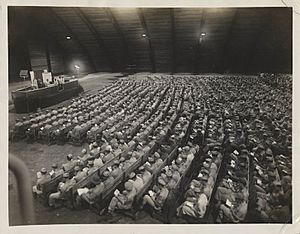
During World War II, about 500,000 American Jews served in the U.S. armed forces. Around 52,000 of them received military awards. Historian Solomon Grayzel noted that over a million Jewish people were in the Allied forces, with the largest number being Jewish Americans.
Major General Maurice Rose
Major General Maurice Rose (1899–1945) was a U.S. Army general during World War II and a veteran of World War I. He was the son and grandson of rabbis. General Rose was the highest-ranking Jewish officer in the U.S. Army at the time.
He was known for being strong and determined. Rose was the highest-ranking American killed by enemy fire in Europe during the war.
Rabbi Goode and the "Immortal Chaplains"
Chaplain Alexander D. Goode, a rabbi, was one of the "Four Chaplains" or "Immortal Chaplains." These four U.S. military chaplains bravely gave up their lives to save other soldiers. This happened when their troop transport ship, the Dorchester, was sunk by a German U-boat in February 1943.
Goode and the three other chaplains (a Methodist, a Roman Catholic, and a Reformed Church minister) helped soldiers get off the sinking ship. When there were no more life jackets, they gave up their own to save more troops. The four chaplains sang and prayed together as the ship went down.
Jewish Scientists and the Atomic Bomb
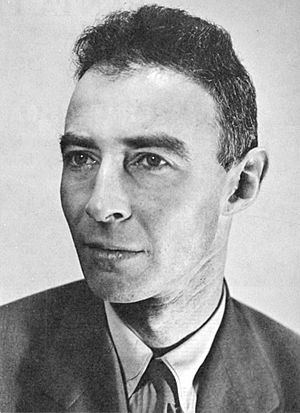
America became a nuclear power because of the Manhattan Project. This secret project during World War II aimed to develop the first atomic bombs. It started in 1939 when Leó Szilárd convinced Albert Einstein to write a letter to President Franklin D. Roosevelt. They were worried that Nazi Germany might be trying to build nuclear weapons.
Albert Einstein (1879–1955) was a brilliant scientist, often called the "father of modern physics." He was Jewish and had to move to the United States in 1933 because the Nazis in Germany were persecuting Jewish people. His books were burned, and he was even on a list of assassination targets.
Leó Szilárd (1898–1964) was a Jewish physicist from Hungary. He came up with the idea of a nuclear chain reaction in 1933. He also wrote the letter for Einstein to sign that led to the Manhattan Project. Szilárd left Hungary because of growing anti-Jewish feelings there.
Szilárd was key to creating the Manhattan Project. He wrote a secret letter to President Roosevelt, explaining the possibility of nuclear weapons and warning about Nazi Germany's work on them. Einstein signed the letter, adding his famous name to the proposal. This letter led to the U.S. government starting research into nuclear fission and eventually the Manhattan Project. Szilárd later helped build the first "neutronic reactor" in Chicago, where the first self-sustaining nuclear chain reaction was achieved in 1942.
J. Robert Oppenheimer (1904–1967) was chosen to be the scientific director of the Manhattan Project. He is often called the "father of the atomic bomb." Oppenheimer was born to a wealthy Jewish family in the United States.
Many other German scientists, including Jewish scientists, were forced to leave Germany and came to the U.S. or its allies. These scientists, like Edward Teller and Niels Bohr, worked to make sure the Allies developed nuclear weapons before the Nazis. Einstein felt a strong connection to his Jewish heritage during this time, writing, "In my whole life I have never felt so Jewish as now."
Einstein's letter and meetings with Roosevelt pushed the U.S. to join the "race" to develop the bomb first. The U.S. used its huge resources to succeed. Germany surrendered before atomic weapons were used against it. However, the U.S. used two atomic bombs on Japan in August 1945, leading to Japan's surrender and the end of World War II.
Korean and Vietnam Wars
Jewish Americans continued to serve in the Korean War and the Vietnam War. Over 150,000 Jewish Americans served in the Korean War, and 30,000 served in Vietnam.
Cold War Contributions
Jewish Scientists and Nuclear Weapons
Jewish scientists played key roles in making the United States the leading power in hydrogen bomb development, after their work on the first atomic bombs. The hydrogen bomb design is named after its creators, Edward Teller and Stanislaw Ulam.
Edward Teller: "Father of the Hydrogen Bomb"
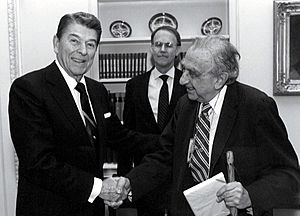
Edward Teller (1908–2003) was born in Hungary to a Jewish family. He left Hungary in 1926 because of anti-Jewish rules. He became a physicist and was known as "the father of the hydrogen bomb."
Teller moved to the United States in the 1930s and was an early member of the Manhattan Project. He pushed for the development of fusion-based weapons, which became the hydrogen bomb. In the 1980s, Teller strongly supported the Strategic Defense Initiative (SDI), also called "Star Wars." This idea was to use ground and space-based systems to protect the U.S. from incoming Soviet missiles. Teller convinced President Ronald Reagan that this system was needed.
Stanislaw Ulam: A Brilliant Mathematician
Stanislaw Marcin Ulam (1909–1984) was an American mathematician of Polish Jewish origin. He was part of the Manhattan Project and helped create the Teller–Ulam design for thermonuclear weapons. He also invented new mathematical tools. Ulam was born in a wealthy Polish-Jewish family in Lwów, which was then part of the Austro-Hungarian Empire.
Commodore Uriah P. Levy
Uriah Phillips Levy (1792–1862) was the first Jewish-American Commodore in the United States Navy. This was the highest rank possible at the time, similar to an Admiral today. He was a veteran of the War of 1812. During his time, he stopped the Navy's practice of flogging (whipping) sailors. He also fought against the anti-Jewish prejudice he faced from other naval officers. His service is remembered at the Commodore Uriah P. Levy Center and Jewish Chapel at the United States Naval Academy.
Admiral Hyman G. Rickover
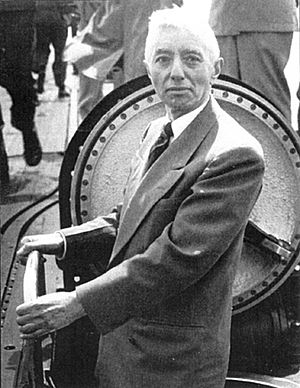
Hyman George Rickover (1900–1986) was born to a Jewish family in Poland. He became a four-star admiral in the United States Navy. He led the development of naval nuclear propulsion and oversaw its operations for 30 years. He is known as the "Father of the Nuclear Navy," which has produced many nuclear-powered submarines and aircraft carriers.
Admiral Rickover was the longest-serving naval officer in U.S. history, with 63 years of active duty.
Admiral Jeremy Michael Boorda
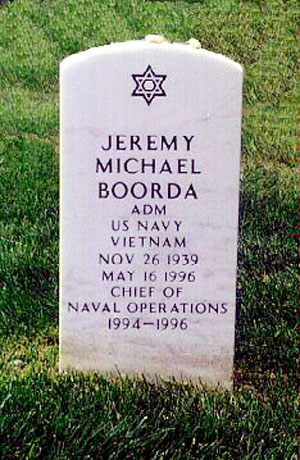
Jeremy Michael Boorda (1939–1996) was an admiral in the United States Navy and the 25th Chief of Naval Operations (CNO). He was the only CNO to rise to this position from the enlisted ranks, meaning he started as a regular sailor. Boorda was born to a Jewish family and had a bar mitzvah. However, he kept his Jewish background private.
Boorda believed that "people should have the opportunity to excel, and be all they can be, even if they don't get a perfect or traditional start." He died in 1996. Researchers have noted that by his time, being Jewish was no longer an issue in the military.
Secretaries of Defense
James R. Schlesinger
James Rodney Schlesinger (b. 1929) served as the U.S. Secretary of Defense from 1973 to 1975 under Presidents Richard Nixon and Gerald Ford. He later became America's first Secretary of Energy. He was born in New York City to Jewish parents from Russia and Austria.
Harold Brown
Harold Brown (b. 1927) was the U.S. Secretary of Defense from 1977 to 1981 under President Jimmy Carter. He was born in New York City to a Jewish family. He helped lay the groundwork for the Camp David Accords, which were peace agreements between Israel and Egypt.
William Cohen
William Sebastian Cohen (b. 1940) was a Republican who served as Secretary of Defense (1997–2001) under Democratic President Bill Clinton. His father was a Russian Jewish immigrant. Although he attended Hebrew school as a child, he chose not to have a Bar Mitzvah and became a Christian.
Intelligence Work for America
Henry Kissinger
Henry Alfred Kissinger (b. 1923) is a German Jewish American political scientist and diplomat. He received the Nobel Peace Prize. He served as the U.S. National Security Advisor (1969–1975) and later as Secretary of State (1973–1977) under Presidents Richard Nixon and Gerald Ford.
Kissinger was born Heinz Alfred Kissinger in Germany to a Jewish family. In 1938, his family moved to New York to escape Nazi persecution. He played a big role in U.S. foreign policy, helping to improve relations with the Soviet Union and China, and negotiating the end of American involvement in the Vietnam War.
John M. Deutch
John Mark Deutch (b. 1938) was the United States Deputy Secretary of Defense from 1994 to 1995 and the Director of Central Intelligence (DCI) from 1995 to 1996. Deutch was born in Brussels, Belgium, to a Russian Jewish father.
Special Forces and Missions
Lawrence N. Freedman, Sergeant Major, United States Army, served for over 25 years in the Army. After earning his green beret, he served in Vietnam and showed great bravery. In 1978, he joined the Army's new counter-terrorist group, Delta Force. In 1980, Freedman was involved in the difficult Iranian Hostage Rescue attempt. He later joined the CIA as a paramilitary officer and was killed in Somalia in 1992. He was known for training the Delta Force and nicknamed himself "SuperJew."
Military Chaplains
The U.S. military has a strong tradition of supporting Jewish military chaplains. These chaplains come from different Jewish groups, including Reform, Conservative, and Orthodox Judaism.
Civil War Chaplains
In 1861, a law was passed saying that all chaplains had to be Christian ministers, which meant rabbis couldn't serve. Jewish groups worked hard to change this law. On July 12, 1862, Congress changed the law to allow non-Christian clergy to be chaplains. Rabbi Jacob Frankel of Philadelphia became the first rabbi appointed as a military chaplain.
The following are the official symbols for Jewish chaplains in the U.S. military:
JWB Jewish Chaplains Council
The JWB (Jewish Welfare Board) Jewish Chaplains Council was started in 1917. It helps Jewish military chaplains who serve in the U.S. Armed Forces and Veterans Affairs. The Council includes rabbis from different Jewish movements and active-duty Jewish chaplains. They support thousands of Jewish service members at military bases and medical centers.
World War II Chaplains
Many Jewish chaplains served with honor during World War II. For example, Rabbi Herschel Schacter was a chaplain in the Third Army. He was the first U.S. Army Chaplain to enter and help liberate the Buchenwald concentration camp in 1945. He later helped people who had been displaced by the war.
Before serving, chaplains from different faiths, including Protestant, Catholic, and Jewish, trained together. They learned to respect each other's beliefs and to offer support to all soldiers, no matter their religion.
After World War II
Rabbi Arnold E. Resnicoff was a Jewish chaplain whose experience after the 1983 Beirut barracks bombing was very important. He was in Beirut when the attack happened. When Vice President George H. W. Bush visited, he asked Resnicoff to write a report for President Ronald Reagan. Reagan later used this report in a speech, which was a big deal because it was rare for a president to quote a rabbi.
Also, a story from the bombing aftermath helped change military rules about wearing kippot (head-coverings) for Jewish soldiers. A Catholic chaplain, Father George Pucciarelli, tore a piece of his uniform to make a makeshift kippa for Resnicoff, whose own kippa was covered in blood from helping wounded Marines. When this story was shared in Congress, a law was passed allowing religious head-coverings in the military. This story was even told by President Reagan, who then asked rabbis to explain the meaning of the kippa. Rabbi Abraham Shemtov explained, "The kippah to us is a sign of reverence."

The Naval Academy Jewish Chapel, also known as the Commodore Uriah P. Levy Center and Jewish Chapel, is the Jewish place of worship at the United States Naval Academy in Annapolis, Maryland. It is named after Commodore Uriah P. Levy, the first Jewish commodore in the U.S. Navy, who was famous for stopping the practice of flogging sailors. The center includes a synagogue, classrooms, and offices.
The center cost $8 million, with much of the money coming from private donations. It was dedicated in September 2005.
Jewish War Veterans of the United States of America
The Jewish War Veterans of the United States of America is an organization for American Jewish veterans. It is the oldest veterans group in the United States, founded in 1896, and has about 37,000 members.
Their purpose is to be loyal to the U.S., promote American values, fight against anything that harms free institutions, defend Jewish people from unfair attacks, and encourage liberty and justice for everyone. They also aim to preserve the memories of Jewish service members and support their families.
National Museum of American Jewish Military History
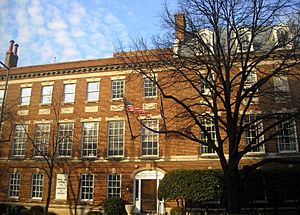
The National Museum of American Jewish Military History (NMAJMH) was founded in 1958 in Washington, D.C. Its goal is to show and preserve "the contributions of Jewish Americans to the peace and freedom of the United States." It also educates the public about the bravery and sacrifices made by Jewish Americans in the armed forces.
The museum is run by the Jewish War Veterans (JWV), USA. It is located in the same building as the JWV National Headquarters.
Misconceptions About Jewish Service
For a long time, there was a misunderstanding that Jewish people were unwilling or unable to serve in the military. This idea lasted for centuries. In response to an 1891 article that suggested a lack of Jewish soldiers, historian Simon Wolf wrote his 1895 book, The American Jew as patriot, soldier and citizen, to show how much Jewish people had contributed.
Even famous author Mark Twain initially criticized American Jews for a supposed lack of patriotism in his 1899 article Concerning the Jews. However, when he was shown facts and statistics proving Jewish participation throughout American military history, Twain changed his mind. He corrected this misunderstanding in his 1904 article, The American Jew as Soldier.
Religious Practices During World War II
During World War II, Jewish American soldiers were able to practice their religion even while serving overseas. Soldiers brought their tefillin (small boxes with scripture) into battle and held Passover seders, even if they were simple and not traditional. Worship services were held wherever possible.
To make worship easier, a Jewish prayer book was created that was approved by Conservative, Reform, and Orthodox rabbis. This book helped make religious practice accessible during the difficult times of war. A committee of rabbis also guided chaplains and answered their questions about worship during the war.


